Here you can add the Main Dish recipes (plain text), along with the picture
so we could make the European Menu.
What is the main dish that could represent your country?


Bramboráky (potato pancake)
Ingredients
You will need:
salt
10ml of milk
groung black pepper
150ml of oil
1kg of potatos
120g smooth flour
2 – 3 cloves or garlic
2 eggs
marjoram
Instructions
Peel the raw potatoes, then wash them and grate them.
Season the grated potatoes with salt and pepper.
Then add eggs, marjoram, add milk and flour as required so the dough is not tough.
Heat a spoon of oil in a frying pan.
Pour a ladle of the mixture into the pan and spread the mixture into a shape of a pancake and fry on both sides until it makes a golden crust.
Serve the potato pancakes as a main or a with meat.
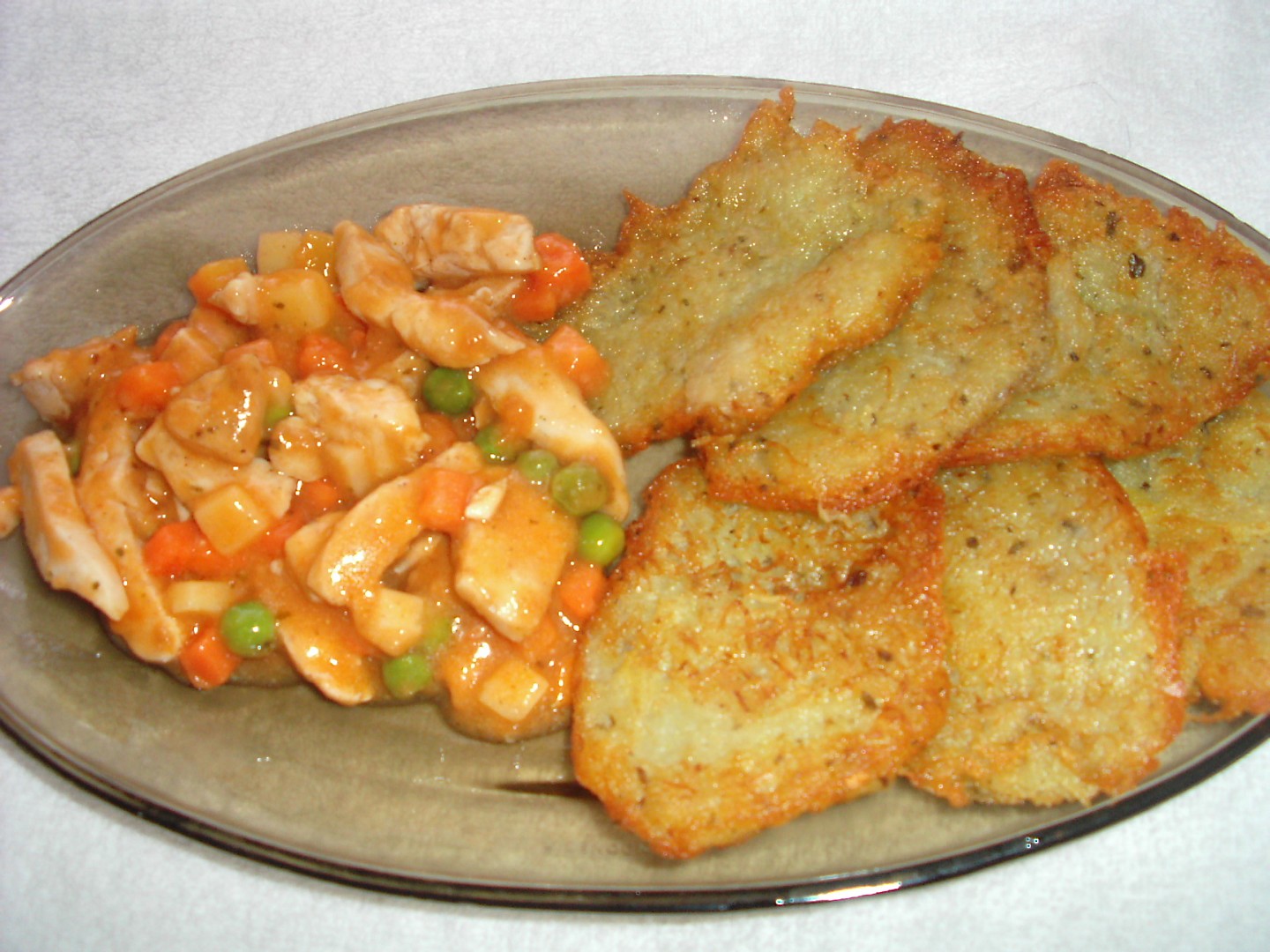
Representatives of Czech team visited Belgium school and met their team. Our pupils also cooked pancakes with cabbage for Erasmus+ project meeting taking place in Sint Niklaas school in the end of April 2017. Our pancakes also ate pupils from Bulgarian school (which is also involved in project Food2explore), Spain, Italy and Ireland for dinner. Our team (Ámal Milan Džuga, Michal Čep, Adam Holuša, Natálie Bakošová, Michal Gřešek and Petr Kaniok) tried dinner prepared by the mentioned countries. It was a unique experience. In the photos are two Michals making the pancakes with cabbage which is cut and mixed with flour, milk, and garlic.
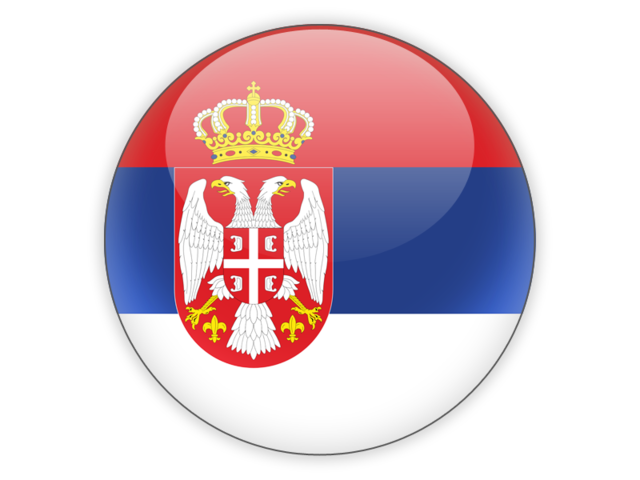
Name: Miljana Tasic
Name of my school: Toplički heroji, Žitorađa
Country: Serbia
Sarma
-
Sarma (Serbian Stuffed Cabbage) is a traditional meal ,not just in Serbia but in most of Balkan countries (Turkey, Grece, Romania and all ex-Yugoslav republics). It is heavy dish that is usually served for the special occasions.
Ingredients (For fifteen cabbage rolls)
- 1 large head of sour cabbage (sauerkraut)
- 500-600gr/1.1-1.3 lbs minced beef
- 600 gr/1.3 lbs dried meet or bacon, chopped
- 500 gr/1.1 lbs smoked ribs or butt
- 1 egg
- 120 gr/0.3 lbs raw rice
- 1 large onion, finally chopped
- 3 gloves of garlic
- 1 big bay leaf
- 2 tsp paprika powder
- 1 tsp whole black pepper
- 2 tbsp of fat (or 1 cup of oil)
- Salt and black pepper to taste oil
Preparation
For the Sarma is very important to use the sour cabbage of the good quality and medium size but also not too sour or salty.
Fry finely chopped onions and 100 g of chopped dried meet (or bacon) on the oil at high temperature. After a few minutes add the minced beef. Add the garlic gloves, salt, pepper to taste and continue to fry it for another 5 minute pressing the meet with your fork to make pieces smaller. Simmer until the meet is done (gets grey).
Take it off the heat and add rice and an egg. Stir well the mixture.
Separate each leaf from the cabbage head and make every root thinner with your knife. Put the cabbage leave on your palm and on the middle of the leave put the mixture (approx. 1 1/5 tablespoons). Lap leave bottom (where the root is) up, than lap the right side to cower a fill and then role. The remaining, left side of the cabbage needs to be tucked in the roll carefully.
In a big pot, place 2-3 cabbage leafs on the bottom. Add the rolls and then the remaining dry meat (500gr) Spread it so it covers the cabbage rolls. Finally add a bay leaf, paprika powder, fat, pepper and cover it with the water. Cook sarma at least 3-4 hours, adding a small amount of water when needed.
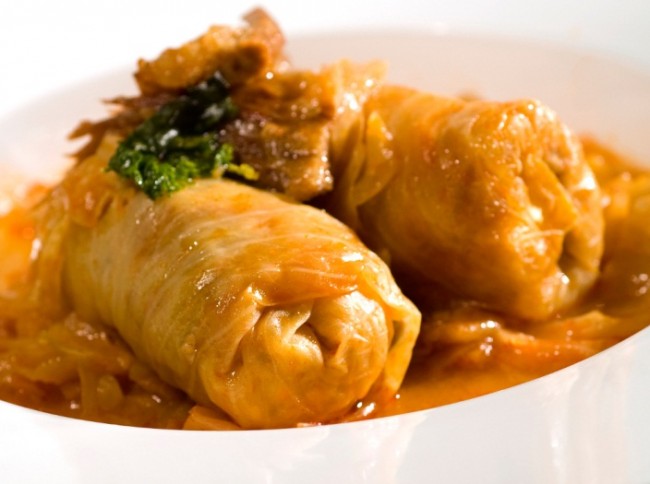
Name: Maša Jeremić
Name of my school: Kosta Abrašević, Beograd
Country: Serbia
Creamy pumpkin soup
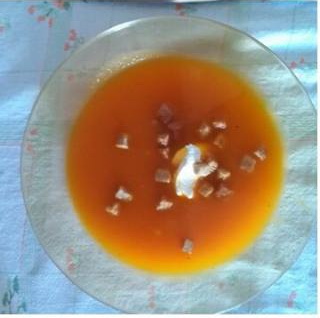
Ingredients:
- 500g of pumpkin
- 1 onion
- 2 carrots
- 3 garlic cloves
- 2 chicken stock cubes
- 100ml tomato juice
- 3-4 strings of parsley
- 1 sour apple
- pepper
Clean the pumpkin, the onion and the garlic, the carrots and the apple. Pour 1,5 l of water into a pot and add tomato juice and chicken stock cubes. Cook for 30 minutes, then add parsley and mix everything in a blender. Sprinkle pepper according to your taste. Serve hot with baked pieces of bread, pumpkin seeds and fresh mint.
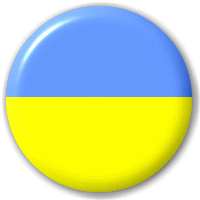
Name: Maria Vovchok
Name of my school: Smila Lyceum
Country: Ukraine
RECIPE OF BORSCHT
Everyone knows that borscht comes from Ukraine! I recently found a recipe of an original Ukrainian borscht and made it. It was very delicious with a great aroma. From that point on I've only been making borscht using this recipe
INGREDIENTS
- 1kg beef (on the bone)
- 2 liters water
- 50 ml vegetable oil
- 1 beet (boil)
- 1 onion
- 200g cabbage
- 1 carrot
- Parsley to taste
- 2 garlic cloves
- 2 bay leaves
- Salt to taste
- 2 tablespoons tomato paste
Number of servings: 10
Wash the meat, cut it into small pieces. Pour some cold water into a pot, salt and cook the meat until it is almost ready. Cut the potatoes into squares and put it in the meat bullion. Cut the beet into strips and fry it with some oil. Cut the onion and the carrots into squares and add them to the beet. Fry until everything is golden-brown. Add some tomato paste and grated tomatoes (without the skin) to fry as well. After a little bit add a cup of bullion. Cut the pepper into squares and add them as well. Stew everything for about 10 minutes. Now back to the bullion. Cut the cabbage into straws and put it in the bullion. After the bullion is boiling, add the mix of fried veggies and tomato paste. Add a lot of greens as well. Cook everything for about 5 minutes and then add a small piece of pork fat (I didn't add any pork fat but the borscht was still amazing) and a squeezed glove of garlic. The borscht is ready. Serve it with some sour creme and croûtons (or bread).
Bon appétit!

Name: Dasha Kucherenko
Name of my school: Monastyryshche School 5
Country: Ukraine
Yushka (Fish Soup)
Really easy to cook. Especially popular for cooking in the open air. Like we did :))
You can use our video instructions.
Ingredients:
water - 2.5-3 l.
carp (can be any fish) - 1 kg
potatoes - 700 g
carrots - 200 g
onions - 1 pc. (Big)
millet - 1/2 glass
bay leaf - 2-3 pc.
salt and pepper
dill and parsley to taste
Preparation
1. Put chopped carrot, onion and diced potato into the boiling water and cook for 20 minutes on low heat.
Meanwhile, cut the fish into portions.
2. Add pieces of fish and bring to boil
3. Add 1/2 glass of millet, bay leaves and cloves of garlic and quickly bring to a boil
4. Add salt and pepper. Cook for 10-15 minutes.
5. When Yushka is ready add some parsley and dill. Put it aside from the heat, cover and let stand 30 minutes.
6. Enjoy Yushka

Name: Victoria Karakostanti 1A
Name of my school: 2nd Gymnasioym of Cholargos
Country: GREECE
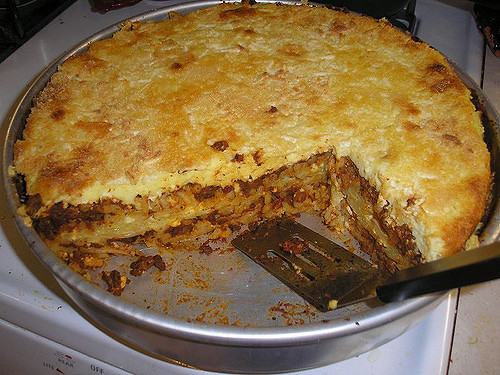
PASTISTIO
INGREDIENTS
- 1/2 kg pasta
- 3 tablespoons melted butter
- 1⁄3 cup grated parmesan cheese
- 1⁄3 cup milk
- 1 egg, beaten
- 1/2 kg ground beef
- 1⁄2 cup chopped onion
- 1 can tomato sauce
- 1 teaspoon salt
- 1 teaspoon dried mint flakes (optional)
- 1⁄2 teaspoon ground cinnamon
- 1⁄8 teaspoon pepper
- 4 tablespoons butter
- 4 tablespoons all-purpose flour
- 1⁄4 teaspoon salt
- 2 cups milk
- 1 egg, beaten
- 1⁄3 cup parmesan cheese
DIRECTIONS
- Cook macaroni drain and return to pan.
- Stir in the melted butter, 1/3 cup Parmesan cheese, 1/3 cup milk, and the egg set aside.
- In a skillet or large saucepan, cook ground beef and onion until meat loses its pinkness and onion is soft drain excess fat.
- Stir in tomato sauce, the 1 teaspoon salt, mint flakes (if used), cinnamon, nutmeg and pepper; set aside.
- In a saucepan, melt 4 tablespoons butter, then mix in flour and 1/4 teaspoon salt.
- Slowly stir in the 2 cups milk, stirring well after each addition so that no lumps form.
- Cook and stir on medium high until cream sauce starts to thicken; stir for one minute more, then remove from heat.
- Beat egg in a small bowl, then pour into cream sauce, stirring briskly.
- Blend in the 1/3 cup Parmesan cheese.
- Layer half the pasta mixture in a 11" x 7" (or 2 quart) baking dish.
- Spoon the meat mixture evenly on top, then the remaining pasta.
- Pour cream sauce over top, to cover completely.
- Bake, uncovered, at 350F for about 40 minutes, or until hot and lightly browned.
- Let stand for 10 minutes.
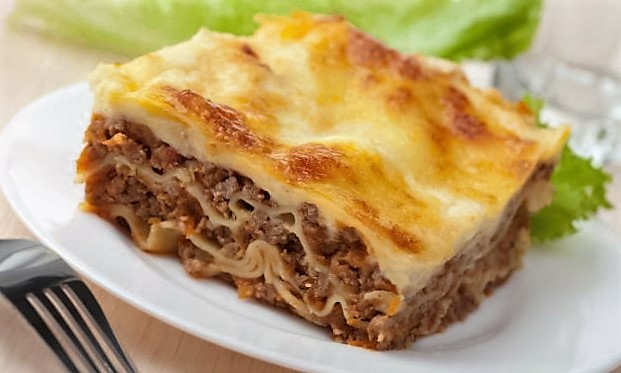
https://www.youtube.com/watch?v=ZrdqXnPesd4




Georgia
Name: Mariam Vardanidze
Country: Georgia
Khinkali
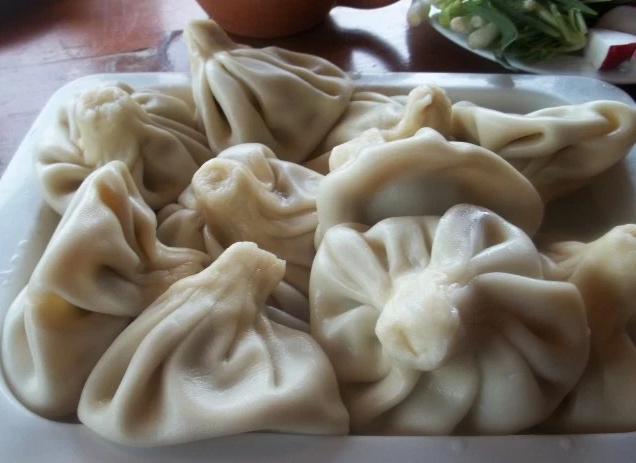
Khinkali (Georgian: ხინკალი) is a very popular Georgian dumpling made of twisted knobs of dough, stuffed with meat and spices. It is considered to be one of the national dishes of Georgia.
Different regions of Georgia make khinkali with different fillings. The most popular filling is a pork/beef mix. In the mountains, khinkali is often made with a lamb filling. Fillings can also include Imeretian cheese mixed with cottage cheese; mushrooms; and mashed potato. City versions include kalakuri khinkali (with thinly chopped parsley) and khevsuruli khinkali (without parsley).
This is how to make them:
Ingredients for 30 Khinkali: Dough – 1.4 kilo of flour (1.1 kilo for the dough and .3 kilo for dusting and kneading) , 2 eggs, 450 ml of warm water; Filling – 700 grams of ground beef and pork mix, salt, half tsp of dried red pepper, quarter tsp ground caraway seed, 2 small onions (optional) and 500 ml of water. Cooking – water and salt for the cooking pot.
Preparation: Add 1.1 kilo of flour to a mixing bowl. Make a depression in the middle of the flour and add the eggs.
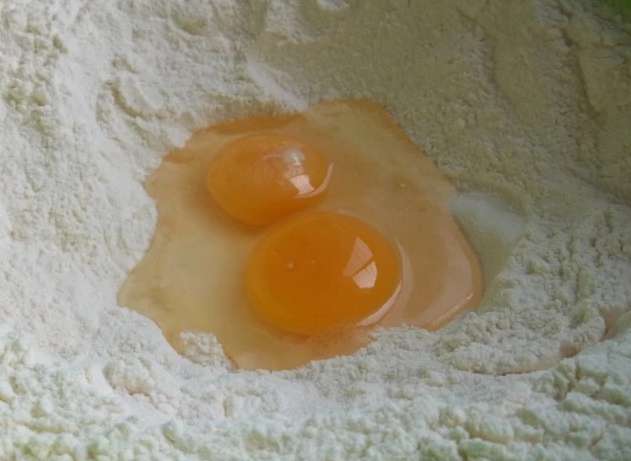
Add 450 ml of warm water. Mix the ingredients from the middle of the bowl until all of the flour is mixed.
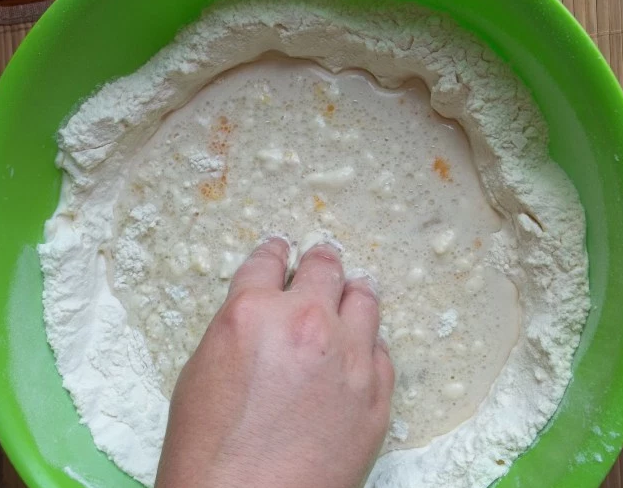
The dough should be formed into a ball. Divide the dough into two pieces. Sprinkle a work surface and one of the balls of dough with flour and knead (very firmly) and fold the dough. Continue kneading and folding until the dough is very firm.
Roll out the dough until it is about 1/3 of an inch thick. Cut out circles of about 2.5 inches in diameter with a drinking glass. Carefully remove the excess dough.
Use a rolling pin to roll each circle into a thin eight inch round. These rounds will be filled with a meat and spice mixture to make khinkali. NOTE: Repeat the whole process of kneading, folding and cutting and rolling of rounds with the remaining ball of dough. You will then have enough rounds to make about 30 khinkali.
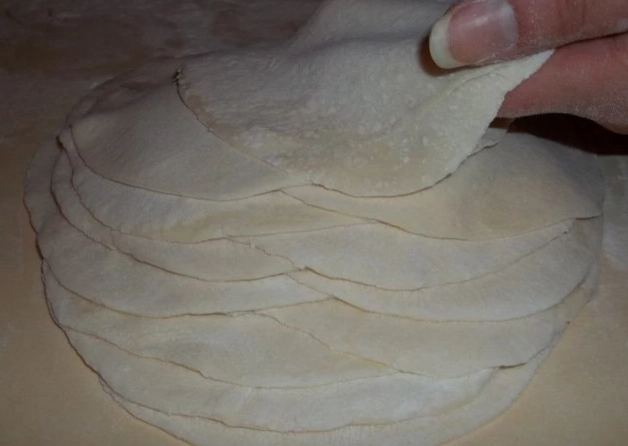
Preparation (the khinkali filling): Add the meat, spices, 2 finely chopped onions (optional – we didn’t use onions) and salt to a mixing bowl. Mix the ingredients by hand and then add 25 ml of water and squash and squash the mixture. Repeat this process 20 times until you have mixed at least 500 ml of water with the meat. This will ensure that your khinkali have lots of ‘juice’.
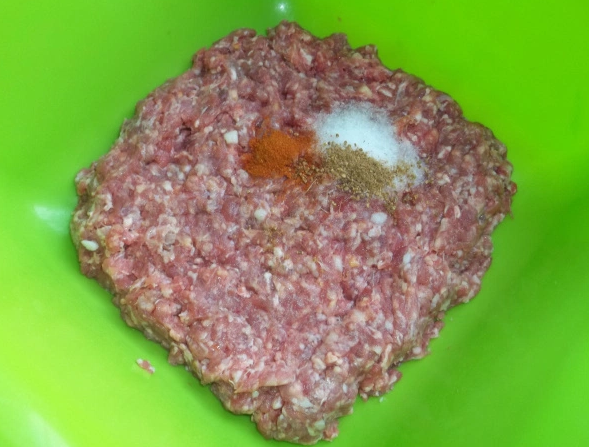
Preparation (making the khinkali): Take one round of dough from your pile of rounds. Add 1 heaped tbs of the meat mixture to the center of the round. Use your thumbs and index fingers to make an accordion type fold all around the outside.
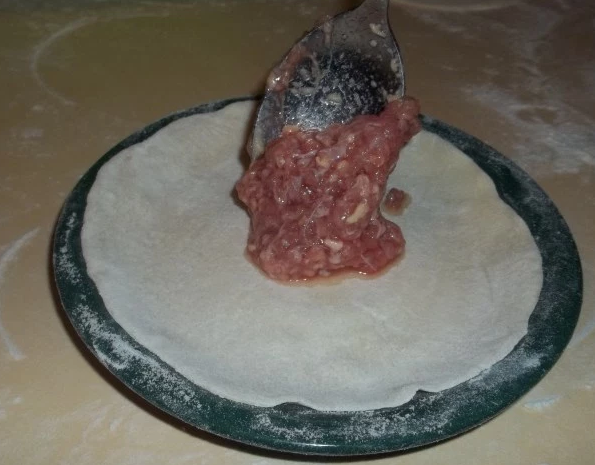
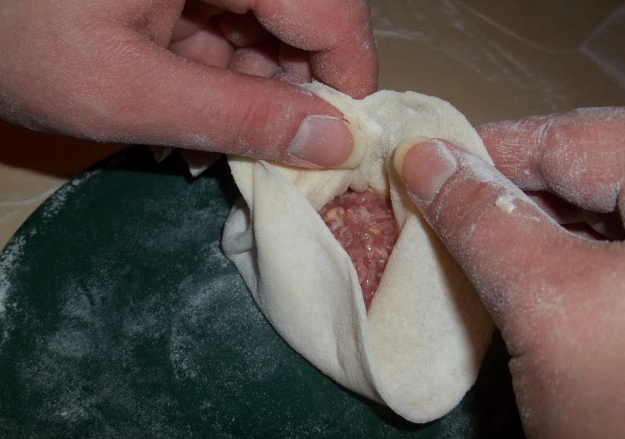
It will become easier with practice! 19 folds are considered to be ideal. When all pleats have been formed the khinkali should look like the one in the picture below. Roll the nubbin of the dumpling between your finger and thumb and pinch off extra dough. The khinkali should look like this.
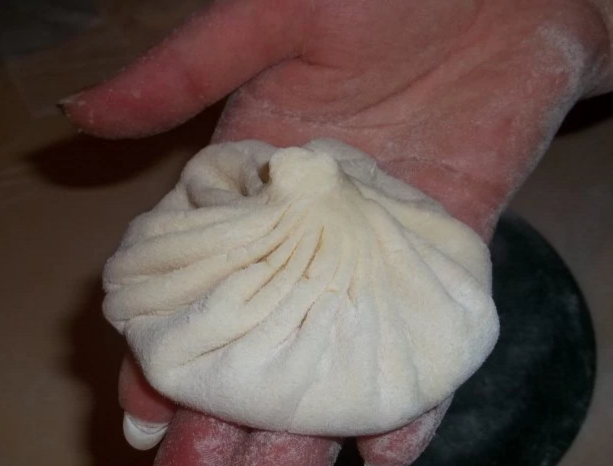
Put each khinkali on a board or work surface that has been dusted with flour. Carefully place the dumplings into a deep pan of boiling salty water, about 10-15 at a time (depending on the size of your pan).
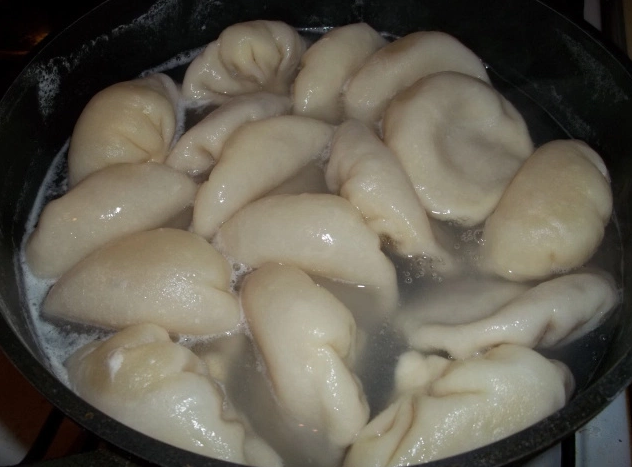
Boil for 12 to 14 minutes. If the dough has been made properly the dumplings will not burst. Serving: Khinkali are served hot with no garnish other than black pepper.
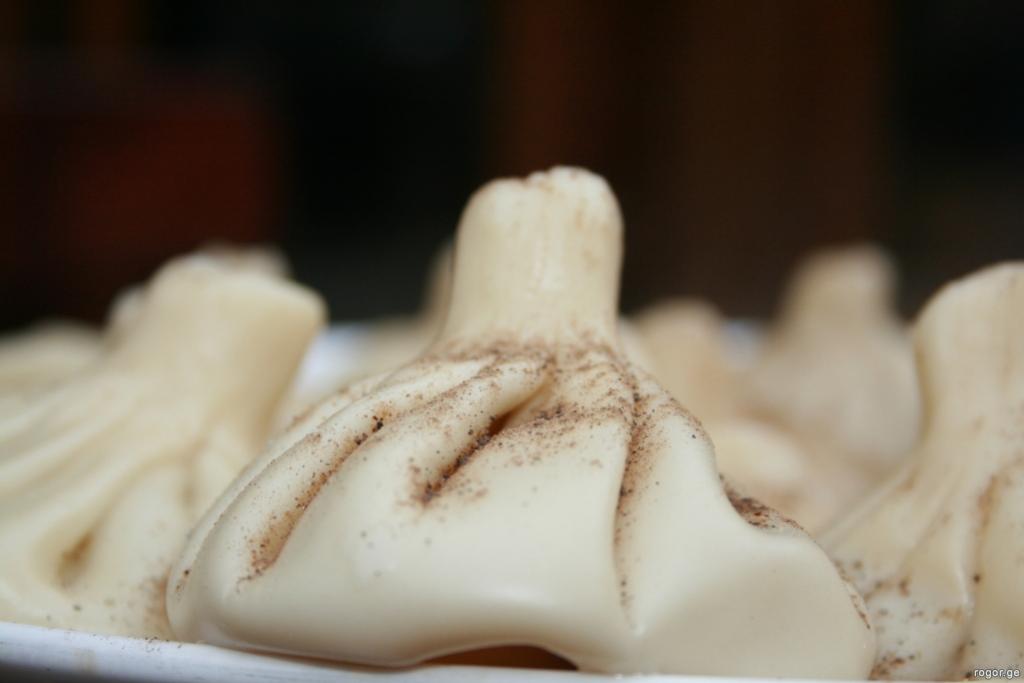
Eating khinkali: There is an art to eating Khinkali. The doughy top, where the pleats all meet, is never eaten, but used as a handle for holding the hot dumplings and is left on the plate to show how many have been eaten. In Georgia, this top is called the “kudi” (Georgian ქუდი, hat) or “kuchi” (Georgian კუჭი, belly button).

Name: Ada Kudzia
Name of my school: ZSZ Bogatynia
Country: Polska
Dumplings with cabbage and mushrooms
Components
2 cups flour l egg
50 dag sauerkraut
5 dag of dried mushrooms
onion
Bay leaf
2 tablespoons linseed oil
salt pepper
Preparation
Dumplings with cabbage and mushrooms - dumplings for Christmas Eve
With flour, eggs, salt pliers and a touch of warm water, knead the elastic cake. Stand aside for 20 minutes.
Soak the mushrooms, soak in warm water. Let drain (keep fluid) and chop. Peel onion, cut, fry on oil. Add mushrooms, frying up a moment.
Cabbage poured in cold water and squeezed. Thickly chop. Pour the mushroom from the mushroom. Add laurel leaf and cook until tender. Add mushrooms with onions, season with. Stir and simmer for about 20 minutes.
The cake thinly roll out. Punch a glass of discs. For everyone to put stuffing and stick to the edges. Dumplings with cabbage and mushrooms boil in salted boiling water 2 minutes after sailing.